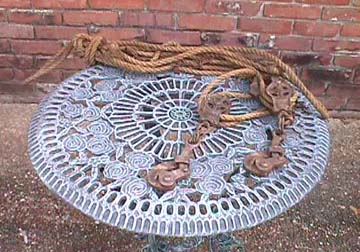
wire stretcher (artifact #5)

This artifact belonged to my father, Fred Arthur Doyle, and was possibly inherited from my grandfather, Charles Arthur Doyle. I used it myself on the farm.
Notice the Hemp Rope. It was installed approximately 60 years ago when I was a boy living on the Farm. I have full memory as to where and how it was stored by my father until it came into my possession. The excellent condition of the rope is because it was kept dry over the years, but of course the rope is old and should be replaced if it was called into service.
Dad and I used this tool for stretching barbed wire when building fence. The work of fence building was not so rushed as gathering crops at harvest time. Work usually occurred during the spring or fall as driving posts is tough work when the ground is dry in the summer months.
The fencing that I speak of was attached to wooden fence posts by steel staples. Common fence posts were split from oak and other timber types. The better grade of post wood was locust and would last many years. Another type of post wood was red cedar, which would last for near a lifetime, provided that is was allowed to dry and season for a few years before being put into the ground. Some of the better wood posts were saved to act as gate posts. Driving posts is done with a tool called a post maul. This is a large, hollow-head steel hammer much like a sledge hammer. The concave shape of the hollow head was much better than a flat-faced hammer because it did not split the wood.
Wire stringing would follow driving the posts. We would normally string one wire at a time. A mesh fence, called hog wire, would usually be topped off with a strand or two of barbed wire to contain larger animals.
On each end of the stretcher tool, there was a slip clamp that held the wire tightly as long as pressure was applied by pulling the rope threaded through the compound pulleys. The wire could be stretched as tight as a fiddle string, and one needed to treat it with respect. If a wire should snap it becomes an unruly weapon. Look to the left of the pulley on the right and you can see the locking device for holding the rope after the wire was pulled taught. This allowed one to staple the wire to the post after pulling a length of wire.
I remember building fence with Uncle Jim Doyle. The barbed wire was carried
as a full spool on a pole into a bluff area known to us as the Monkey Slide. The
only practical approach was sliding down into the ravine where there was a break in the
bluff. Most likely we used this stretcher for that job. It was a memorable
experience for a young boy.
Charles D. Doyle 5/6/03